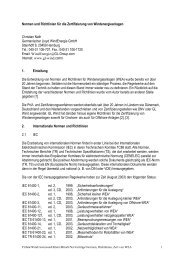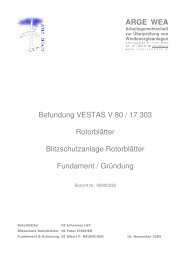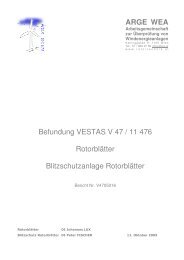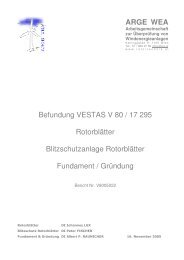Grundlagen Epoxydharze - Kap. 1 Arbeitsanleitungen
Grundlagen Epoxydharze - Kap. 1 Arbeitsanleitungen
Grundlagen Epoxydharze - Kap. 1 Arbeitsanleitungen
Sie wollen auch ein ePaper? Erhöhen Sie die Reichweite Ihrer Titel.
YUMPU macht aus Druck-PDFs automatisch weboptimierte ePaper, die Google liebt.
VERKLEBUNGENGLUED BONDS1MessingAnschleifen und entfetten.BrassGrind and degrease the surfaces.NickelAnschleifen und entfetten oder ca. 5 Sekunden mit konzentrierter Schwefelsäure*behandeln, mit klarem kaltem und warmem Wasser spülen und trocknen.Nylon/PolyamideAnschleifen/feinsandstrahlen und entfetten mit Aceton.Polyester-FormstoffeAufrauhen mit Schleifpapier und entfetten mit Aceton.Polyethylen/PolypropylenDie Verklebung dieser thermoplastischen Kunststoffe ist sehr schwierig. Inkeinem Falle werden die Festigkeiten von Metallverklebungen erreicht.Zunächst werden die Teile mit Aceton entfettet und in einem Bad nach folgenderRezeptur geätzt*:1,0 kg konzentrierte Schwefelsäure80 g Kaliumbichromat50 g WasserPE und PP wird bei einer Badtemperatur von 70 °C ca. 2 Minuten behandelt,anschließend mit Wasser gespült und getrocknet. Neben der chemischen istauch eine thermische Vorbehandlung möglich. Dazu wird die Oberfläche miteiner nicht leuchtenden Gasflamme kurzzeitig leicht abgeflammt, bis sie blankerscheint. Das Schmelzen des Kunststoffes ist zu vermeiden.Polystyrol-SchaumstoffeSchmutz abschleifen, Schleifstaub absaugen.Saubere Oberflächen benötigen keine Vorbehandlung.Polyurethan-SchaumstoffeSchmutz abschleifen, Schleifstaub absaugen.Saubere Oberflächen benötigen keine Vorbehandlung.NickelGrind and degrease the surfaces, or treat them for approx. five seconds withconcentrated sulphuric acid*. The surfaces are then rinsed under clear hotand cold water and dried.Nylon / polyamidesGrind, fine-sandblast, and degrease the surfaces with acetone.Moulded polyester materialRoughen the surfaces with abrasive paper, and degrease them with acetone.Polyethylene/polypropyleneThese thermoplastics are bonded only with great difficulty. In no event arethe strengths of metal bonds obtained.The parts are first degreased with acetone and etched* in a bath with thefollowing constituents.1.0 kg concentrated sulphuric acid80 g potassium bichromate50 g waterPE and PP are treated in a 70 °C bath for about two minutes, then rinsedwith water and dried. Pretreatment is not restricted to chemical processes,heat can also be used. In this case, the surface is briefly held in a nonluminousgas flame until it appears polished. The plastic should not beallowed to melt.Polystyrene foamsGrind off soiling, suction off grinding dust.Clean surfaces do not have to be pretreated.Polyurethane foamsGrind off soiling, suction off grinding dust.Clean surfaces do not have to be pretreated.Magnesiumund Magnesium-LegierungenAufrauhen mit Schleifpapier und entfetten, Klebstoff sofort auftragen, da sonstdie Oberfläche wieder oxidiert oder chemische Vorbehandlung (ca. 5 Minuten)in einer 75 °C warmen Lösung* aus:1,0 kg Natriumhydroxid8,0 l Wasseranschließend wird mit kaltem Wasser gespült und in folgender Lösung geätzt*:1,0 kg Chromsäure10,0 l Wasser6 g NatriumsulfatAnschließend erfolgt eine Spülung mit kaltem und warmem Wasser sowie dieTrocknung. Klebstoff sofort auftragen.PTFE(wie z.B. Teflon ® )Die Verklebung ist sehr schwierig. Zunächst wird ein Tränkbad nach folgenderRezeptur hergestellt:In 1 l Tetrahydrofuran werden 130 g Naphtalin gelöst. Anschließend gibt man23 g in kleine Würfel geschnittenes metallisches Natrium bei. Nach 2 Stundenist die Lösung gebrauchsfertig. Die Lagerstabilität beträgt ca. 2 Monate. DieFügeteile werden mit Aceton entfettet und dann 15 Minuten in das Natrium-Naphtalin-Bad getaucht. Danach wird gründlich mit Aceton gewaschen undmit Wasser gespült. Durch die Behandlung verändert sich die Oberfläche desPTFE und verfärbt sich schwarz-braun.1.34Magnesiumand magnesium alloysRoughen the surfaces with abrasive paper, and degrease them. The adhesivemust be applied immediately, otherwise the surface will again oxidise. Alternatively,chemical pretreatment for about five minutes in a 75 °C solution* of1.0 kg sodium hydroxide8.0 l waterThe surfaces are then rinsed with cold water and etched* in the following solution:1.0 kg chromic acid10.0 l water6 g sodium sulphateFinally the surfaces are rinsed with cold and hot water and dried. Theadhesive must be applied immediately afterwards.PTFE(for example Teflon ® )PTFE is bonded only with great difficulty. First of all, an impregnating bathis prepared with the following constituents.First, 130 g of naphthalene are dissolved in one litre of tetrahydrofuran. Now23 g of finely diced sodium metal are added. After two hours the solution isready for use. The shelf life is about two months. The parts to be joined aredegreased with acetone and then immersed for fifteen minutes in thesodium-naphthalene bath. Afterwards, the parts are washed thoroughly withacetone and rinsed with water. This treatment causes the surface of PTFE toturn a blackish brown colour.Ausg./Ed. 01.03 Änderungen vorbehalten / Modifications reservedR&G Faserverbundwerkstoffe GmbH • D-71111 Waldenbuch • Fon 0 71 57/53 04 60 • Fax 0 71 57/53 04 70 • www.r-g.de










